Ijraset Journal For Research in Applied Science and Engineering Technology
- Home / Ijraset
- On This Page
- Abstract
- Introduction
- Conclusion
- References
- Copyright
Artificial Neural Network Based Integrated Ambulance System
Authors: Dr. K. Ragini, Spoorthi G Kunch, B. Sathvika, K. Swathi, G. Prashanthi
DOI Link: https://doi.org/10.22214/ijraset.2023.54184
Certificate: View Certificate
Abstract
In emergency situations, almost all hospital beds were fully occupied, and the entire health department had to collapse. and the issues faced by the ambulance drivers who take the patients to the hospital had to wait outside the hospital for a prolonged time due to the unavailability of beds, ventilators, medical ICU, and a lack of oxygen supply, which led to the deaths of many patients. The major issue faced is that there is no proper system connecting all hospitals nearby for analyzing the condition of the patient inside the ambulance at the same time, and hospitals with the required equipment should be chosen at the right time. To prevent these situations, a system has been proposed in which decision-making will be done by analyzing the patient\'s condition using artificial neural networks and by retrieving information about the hospital and medical system\'s availability from a centralized server page connecting to all nearby hospitals.
Introduction
I. INTRODUCTION
Almost all hospital beds were filled during the emergency, and the health department crumbled due to several problems. Due to the scarcity of beds, ventilators, medical ICU beds, and oxygen supplies, the ambulance drivers were forced to wait outside the hospital for an extended period of time, which caused the patients to pass away inside the ambulance.
A method that uses an artificial neural network to monitor the patient's condition while they are in the ambulance has been developed to prevent this from happening; the proper hospital should be selected at the right moment.
The artificial neural networks will use the patient's biomedical parameters, such as Spo2 (pulse oximeter), respiratory, heartbeat (beats per minute), and body temperature, to determine the patient's condition. From there, it will classify the patient's needs, such as oxygen bed support, ventilator support, and MICU support, by confirming the networked medical system's hospital availability.
II. LITERATURE REVIEW
Title: Online AI Bot for Emergency Service and Mobile Medicine Recognises STEMI in Electrocardiogram (ECG) Year:2021
Authors: Jen-Yeu Chen, Serkan Kavak, and Shi-Jim Yen Description: Emergency medical care in rural areas frequently requires prompt medical decisions and on-board medical care in ambulances before patients can reach hospitals. The need for prompt medical care, for instance, follows a myocardial infarction (heart attack). In this case, the hardware connections are implemented using the Arduino platform, and programming is done using the Arduino IDE. We anticipate that the final result of our initiative will lower the potential fatality rate owing to delays.
Title: Association between patients' medical histories and the reason for calling ambulance services using data mining based on emergency medical databases.
Title: Data mining based on the emergency medical database the association between the reason of calling ambulance service and the medical history of patients Year: 2016
Author: Jhe-Nan Lin; Wei-Zen Sun; Huei-Ming Ma; Meng-Han Yang
Description: The amount of data available for analysis is skyrocketing across a wide range of application areas, including the medical and biological sciences. This study has attempted to mine the relationship between the patient's medical histories and the cause for calling the ambulance service using the emergency medical database. It's possible that chronic diseases are the source of the acute conditions that prompt people to call an ambulance. The connections found by this research could be useful for creating suitable chronic illness management.
Title: Tracking ambulances with a patient health surveillance system
Description: You can utilize a patient health monitoring system in conjunction with ambulance tracking while using GPS modem.
Additionally, it serves as a system for monitoring the health of patients. Using a GSM modem, these details are relayed to the hospital through SMS.
- It serves three key purposes in this system:
- SMS-based patient health monitoring.
- Ambulance carrying the patient is being tracked using GSM and GPS technology.
- To use GSM technology to send the aforementioned two information to the hospital or doctor.
This device allows us to monitor a patient's numerous health markers while also determining the location of the ambulance. These variables include the following: temperature, humidity, and heart rate. The position and values of each sensor are communicated as a text message to a doctor's mobile device. Or it can send this text message to any hospital employee with permission. Then, that person can inform the doctors of the location of the ambulance and the condition of the patient. The doctor can make the appropriate preparations for the patient's therapy utilizing these criteria..
III. PROPOSED SYSTEM
In the existing system, the patient’s health condition is being monitored using sensors and microcontrollers. Based on the readings, medical staff will analyze the condition of the patient. The drawback of this system is that there is delay in analyzing the condition of the patient. But in the proposed system, by using a feed-forward neural network- backpropagation algorithm, the AI system is analyzing the condition of the patient, this makes analyzing the condition of the patient more accurate without any further delay. The AI system will also fetch the details like availability of the hospital from the centralized server page connected to all the hospitals nearby.The artificial neural network algorithm is designed by taking four biomedical parameters as inputs: body temperature, heartbeat, respiratory rate, and SPo2 (pulse oximeter). The patient's condition will be assessed using the sensors to measure it and the algorithm to analyze it. The ambulance driver will be helped by the telegram bot, which will receive the patient's condition and provide the hospital with the necessary amenities.
There are different conditions for determining the condition of the patient:
- Temperature: The typical temperature of the human body is between 97 and 99 degrees Fahrenheit. The extreme critical state of a human body temperature would be more than 102 degrees Fahrenheit, whereas the moderate critical condition would fall between 100 and 102 degrees.
- SPo2 ranges: The normal SpO2 range for the human body is greater than 95%. The human body's SpO2 would be in a moderately critical condition if it were between 93% and 94%, and it would be in an extremely critical condition if it were less than 92%.
- Pulse rate ranges: The normal pulse rate ranges for the human body are between 40 to 100 BPM. The human body's pulse rate would be in a moderately critical condition if it were between 110 to 130 BPM, and it would be in an extremely critical condition if it were greater than 130 BPM. Respiratory ranges:
Normal respiration rates would range from 12 to 18 breaths per minute. Respiratory rates would vary by age and the activities performed by humans.
A. Block Diagram
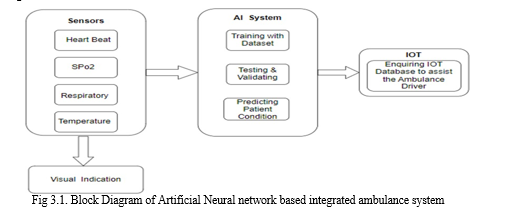
As illustrated in the block diagram of figure 3.1, sensors like Heart beat, SPo2, Respiratory, Temperature are connected to the ESP32 processor. The serial communication takes place between the ESP32 and ESP8266 . Sensors data is interfaced into the AI system. Based on the sensor data the patient condition is analyzed. By predicting the patient condition ,if the patient is at moderate critical or extreme critical condition then the database will assist the Ambulance driver.
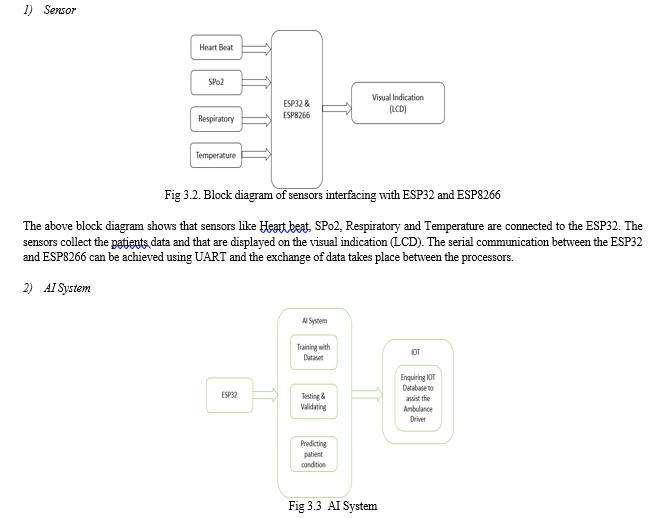
The above block diagram shows that the artificial neural networks algorithm is designed in ESP32.In AI System the data is trained with the dataset. Testing and Validating the patient condition by taking four biomedical parameters as inputs: body temperature, heartbeat, respiratory rate, and SPo2 (pulse oximeter). The patient's condition will be assessed using the sensors to measure it and the algorithm to analyze it. The data is trained by taking the three different patient conditions as normal condition, moderate critical condition and the extreme critical condition.Based on the sensor data the condition of the patient is predicted. Enquiring IOT database to assist the ambulance driver.
IV. BACKPROPAGATION IN NEURAL NETWORK
The Backpropagation Algorithm, as shown in fig 4.1, commonly used for training artificial neural networks to improve the accuracy of predictions. While back propagation used to analyze the sensor data related to the patients. This determines the patient's condition by taking the sensor's data as input and makes predictions based on the data.
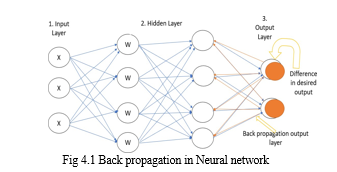
The neural network model is trained using the backpropagation algorithm on a dataset of sensor data. During the training , the algorithm will adjust the weights and biases of the neural network to minimize the difference between the predicted output and actual output. After testing and validating the input , predicting the patient condition as normal condition, moderate critical condition or extreme critical condition. Based on the sensor's input data the neural network produces the predicted output accurately.
In a neural network ,the processing takes place in a hidden layer through a series of mathematical operations that transforms the sensor data into a form that can be used to make the predictions.Each neuron in the hidden layer receives inputs(sensor data) from the neurons in the previous layer, which are multiplied by a set of weights and passed through activation function. The output of the hidden layer is then passed on to the neurons in the next layer as inputs.The weights which are present in the neural network are adjusted during the training process using the backpropagation algorithm. This calculates the gradient of the error function with respect to the weights , by updating the weights the error can be minimized.
To determine the output of the neural network the activation function is used in the hidden layer. Activation function is commonly used to include the sigmoid function, the rectified linear unit(ReLU) function and hyperbolic tangent function. This function has its own strengths and weaknesses and the choice of the activation function will depend on the specific task as to analyze the patient condition and dataset as sensor data.The processing in the hidden layers of a neural network can be complex and nonlinear, allows the network to learn complex patterns and relationships in the input data.
V. RESULTS AND DISCUSSION
- First the patient will place their finger on the heartbeat sensor , the LED which is present on the PCB will glow and with this it can be measured if there are any abnormalities in the Heartbeat.
- From the heartbeat itself it’ll measure the respiratory and also in parallel SPo2 will also be measured.
- The temperature sensor is in the form of a wire with a metallic end , by holding the metallic end the temperature of the patient will be measured.
- The values of Heartbeat, Temperature, SPo2, Respiratory sensor outputs will be displayed on the 2*16 LCD.
- These values will later be sent to the telegram Channel Group by the AI bot. Fetching of hospital details according to the availability will be done accordingly.
- Figure. 5.1 shows the output display of, the sensor values in the 2*16 LCD, interfacing of sensors with Artificial Intelligence.
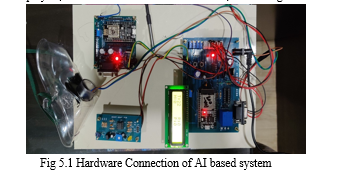
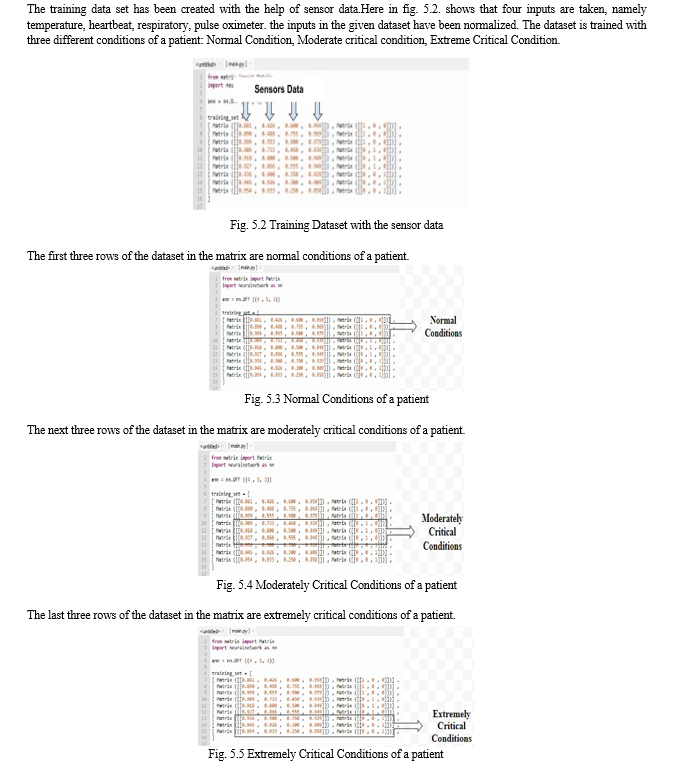
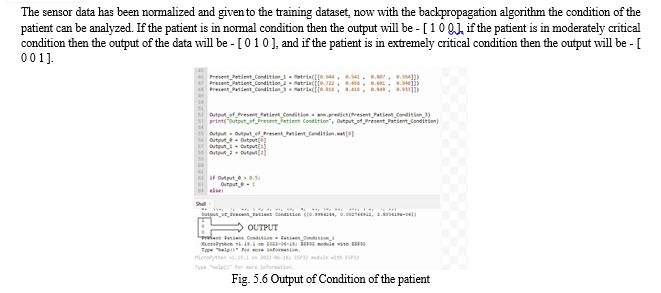
VI. ACKNOWLEDGEMENT
It is our proud privilege to express the feelings of gratitude to several people who helped us in completing this paper work.
We take this opportunity to express our heartfelt gratitude to our esteemed guide, Dr. K. Ragini, Professor, ECE department, GNITS for her constant guidance, encouragement and immense motivation.
We express our heartfelt gratitude to Dr. B. Venkateshulu, Head of the Department, ECE department, GNITS for his constant guidance and moral support.
Finally, we would like to thank all the faculty and staff of ECE department who helped us in completing the paper.
Conclusion
In this paper the condition of the patient will be analyzed with the help of Artificial Neural Networks , using the backpropagation algorithm. Selection of the hospital according to the patient\'s condition with the hospital web page server. Hospital choosing decisions will be made by the Artificial Intelligence based system by fetching the details from the centralized server page connecting to all hospitals nearby. The Artificial Intelligence based hardware system will take the biomedical parameters of Patient such as Spo2(Pulse oximeter), HeartBeat, Respiratory levels and body temperature and it will process with the backpropagation algorithm using feedforward neural networks, and decides what the patient needs like oxygen bed support, ventilator support, and MICU support by checking with the networked medical system availability hospital using IoT. By the AI categorization of medical sensor values, the patient can be categorized in suitable support.
References
[1] Bassey Isong, Nosipho Dladlu, Tsholofelo Magogodi, \"Mobile-Based Medical Emergency Ambulance Scheduling System\", International Journal of Computer Network and Information Security (IJCNIS), Vol.8, No.11, pp.14-22, 2018.DOI: 10.5815/ijcnis.2018.11.02. [2] Periasamy JK, B.Latha.(2019) \'Efficient hash function based duplication detection algorithm for data Deduplication deduction and reduction. Concurrency Computat Pract Exper. https://doi.org/10.1002/cpe.5213 [3] Periasamy JK, B. Latha (2019) \'An enhanced secure content deduplication identification and prevention (ESCDIP) algorithm in cloud environment, Neural Computer & Application.\'. https://doi.org/10.1007/s00521-019- 04060-9. [4] Periasamy J.K , B.Latha (2018), \'Secure and duplication detection in cloud using cryptographic hashing method\' in International Journal of Engineering & Technology, VOL.7.pp.105-108.. DOI: 10.14419/ijet.v7i1.7.9585.
Copyright
Copyright © 2023 Dr. K. Ragini, Spoorthi G Kunch, B. Sathvika, K. Swathi, G. Prashanthi. This is an open access article distributed under the Creative Commons Attribution License, which permits unrestricted use, distribution, and reproduction in any medium, provided the original work is properly cited.

Download Paper
Paper Id : IJRASET54184
Publish Date : 2023-06-18
ISSN : 2321-9653
Publisher Name : IJRASET
DOI Link : Click Here
 Submit Paper Online
Submit Paper Online

